Last weekend I had the honor of teaching two workshops at Iron Gate Exhibition (IGX). One was “Random Acts of Violence: Weird & Quirky Plays of Rapier & Smallsword” that I debuted at Lord Baltimore’s Challenge. The other was a new workshop on basic principles of disarms found in the greater Franco-Italian school of fencing in rapier and smallsword.
While what we experience in HEMA/SCA is a sport version of the martial art, it’s important to remember that a lot of the techniques taught and used were meant to deal lethal blows. This is a serious action and not one to be taken lightly. Often, fencing masters would promote disarms as a healthy alternative to a lethal blow. This is especially true among 17th Century French fencing masters who begged folks to not kill each other but to seek the disarm instead, stating that victory via disarm is even more honorable.
These drills are listed as Student/Coach roles, however, they can be done by two fencers as training partners. They should switch roles after a pre-determined amount of time or reps.
These are just a selection of disarms and fencers should experiment with the principles/patterns shown in these sequences to come up with their own variations. For more info on Italian rapier disarms, I highly recommend this video by Maestro David Coblentz and Maestra Dori Coblentz.
I’m hoping to update this blog in the future with video examples of each play.
You can download a PDF of these plays here.

Safety Measures
- Depending on the hilt type/size, it can be easy to break someone’s hand and/or fingers.
- Go slower and gentler when your partner is holding the sword in a closed-key grip (aka the index finger around the ricasso).
- You can go smoother when the sword is held just around the grip.
- Don’t pull your partner’s sword/hilt straight at you. If they suddenly let go or the sword breaks free, you could hit yourself square in the face.
General Principles
- Move opponent’s sword toward the “seam” of their fingers, starting with the pinky and levering out.
- Make sure the opponent is well committed in their attack so they can’t easily counter your disarm.
Disarm Plays from the Inside Line
Disarm from the Pommel

| STUDENT | COACH |
|---|---|
| Finds the Coach’s blade on the Outside Line | |
| Attacks via cavazione to the high-inside line | |
| Parries the attack (quarta) and steps in.
Reach over your sword/arm and get hand beneath the opponent’s pommel. Pull back on the pommel while levering down against their blade with your sword, levering it free. |
|
| Releases sword. |
NOTE: This disarm can be difficult if the opponent has a small pommel, such as the round pommels in the Castille economy rapiers. Grabbing the hilt can also work, but only try against cup hilts; trying to disarm at the hilt with an open swept hilt can be dangerous to your own fingers if your opponent tries to wretch or twist free.
Disarm from the Forte

| STUDENT | COACH |
|---|---|
| Finds the Coach’s blade on the Outside Line | |
| Attacks via cavazione to the high-inside line | |
| Parries the attack (quarta).
Reach over your sword/arm and pinch the flat of the Coach’s forte between your thumb and your index & middle finger. Push against the blade with your sword as if delivering a horizontal cut to their flank while raising their hilt high with your offhand. |
|
| Releases sword. |
NOTE: This is pretty similar to the first to the above; both are pretty standard disarms that appear in several Franco-Italian manuals. The difference is in the measure. In the first play, we can reach the pommel either by stepping in or having a longer reach than our opponent. In this second play, we can’t reach the pommel.
An alternative to this action is instead of grabbing over your arm, grab the opponent’s sword behind your own (around the middle of their blade) and then violently drive your hilt/crossguard upward (as shown in the Pascha plate above).
Disarm from the Debole

| STUDENT | COACH |
|---|---|
| Finds the Coach’s blade on the Outside Line | |
| Attacks via cavazione to the high-inside line | |
| Parries the attack (quarta).
Reach under their sword so your forearm comes under their blade (assuming same handedness, from their outside to their inside line); their debole should be under your armpit. Wrap your hand on top of the blade. |
|
| Disengage your sword underneath theirs, and strike violently upward underneath the forte of their sword. | Releases sword. |
NOTE: This is much more of a smallsword disarm than it is rapier. You need to be safely passed the tip and make sure you’ve secured three points of contact to keep yourself safe from being cut if the opponent tries to pull their sword free. The three points of contact are sandwiched between your arm and ribs, your forearm, and your hand.
The image shows a variation of this play from Angelo after parrying a thrust in prime.
Disarm Plays from the Outside Line
Disarm Against a Weak Finding

| STUDENT | COACH |
|---|---|
| Poorly finds the Student’s blade on the Outside Line. | |
| Strikes in terza or seconda, through the weak angle of the Coach’s blade. | Receives hit to chest. |
| While keeping the point in the Coach’s chest, reaches with the offhand to the debole of the Coach’s blade and rotate it around their own sword toward their outside line and lever it free. | |
| Releases sword. |
NOTE: This disarm appears in Alfieri (Plate 19). It also appears in Capoferro as a disarm with the dagger (Plate 24).
It’s also important to note that not all disarms are meant to be a replacement from striking your opponent. Disarming your opponent after striking them means they can’t strike you. A strike & disarm combo effectively ends the fight immediately.
Disarm via Feint
| STUDENT | COACH |
|---|---|
| Finds the Student’s blade on the Outside line. | |
| Feints via cavazione to the Inside line. | Moves to parry the feint. |
| Eludes the parry and strikes in terza or seconda on the outside line. | Receives hit to chest. |
| While keeping the point in the Coach’s chest, reaches with the offhand to the debole of the Coach’s blade and rotate it around their own sword toward their outside line and lever it free. | |
| Releases sword. |
NOTE: This disarm is an alternate play in Alfieri’s Plate 19.
Disarm via Offhand Parry

| STUDENT | COACH |
|---|---|
| Find Coach’s blade on the Inside line. The offhand is near the sword arm by the elbow or hilt. | |
| Attacks via cavazione to the Outside line. | |
| Parries the attack with the offhand and brings it to their far inside line.
Simultaneously, they turn their hand in quarta and strike with an angled, false-edge attack (punta dritto) around the Coach’s sword on the Outside line. Footwork can be a lunge, cross-line lunge, or a passing lunge. |
Receives hit to chest. |
| While keeping the point in the Coach’s chest, rotates the Coach’s sword around their own sword and lever it free. | |
| Releases sword. |
NOTE: This is basically the open offhand version of what appears in Capoferro Plate 24, adapted to single rapier.

Disarm via Hanging Parry, with Pommel Bash

| STUDENT | COACH |
|---|---|
| Find Coach’s blade on the Inside line. | |
| Attacks via cavazione to the Outside line. | |
| Parries the attack with a hanging/yielding seconda (aka a classical fencing prime). | |
| Reach underneath their arm and seizes the forte of the Coach’s blade. | |
| Steps forward and performs a pommel bash to the face while twisting the Coach’s blade/hand position into quarta and raising it to the sky. | Releases sword and receives hit to the mask. |
NOTE: This disarm appears in Pascha. It’s a bit of a long action, but even if the opponent is able to parry the pommel bash, there’s still the disarm.
Disarm via Hanging Parry, with Mandritto

| STUDENT | COACH |
|---|---|
| Find Coach’s blade on the Inside line. | |
| Attacks via cavazione to the Outside line. | |
| Parries the attack with a hanging/yielding seconda (aka a classical fencing prime). | |
| Reach underneath their arm and seizes the forte of the Coach’s blade. | |
| Clears their sword from the Coach’s sword by cutting around their own head and throwing a mandritto fendente or mandritto squalembratto to the Coach’s head. Simultaneously, twisting the Coach’s blade/hand position into quarta and raising it to the sky. | Releases sword and receives hit to the mask. |
NOTE: This disarm appears in L’Ange. Even if the fencer doesn’t intend for their cut to actually land, the sight of the cut being prepped while not being able to release their own sword can be incentive enough for the opponent to release their blade and step away.
Photo Credit: The Crowe Family at IGX 2022
DONATIONS: If you found this post useful, please consider a small donation to my school, so I can continue to produce rapier & other historical martial arts content. Donate at https://www.paypal.com/paypalme/BostonAcademiedArmes.



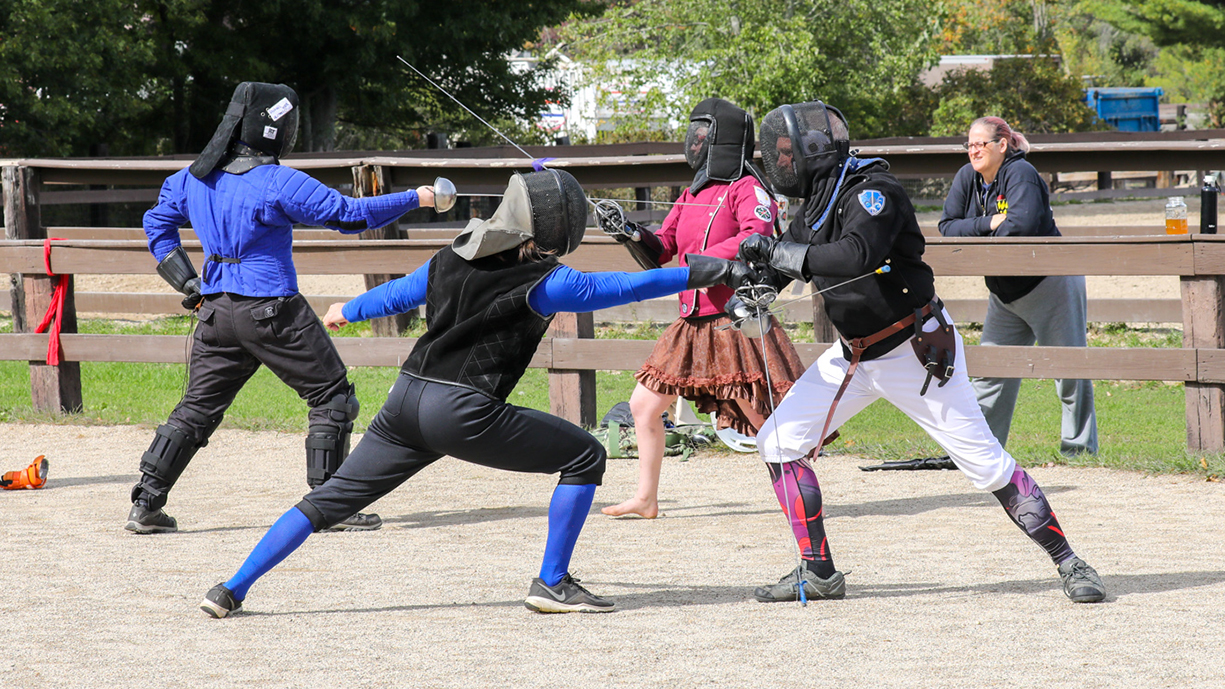
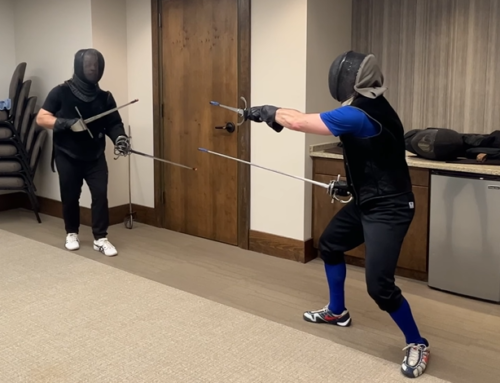
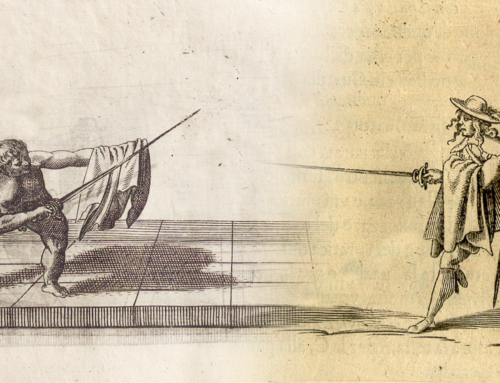


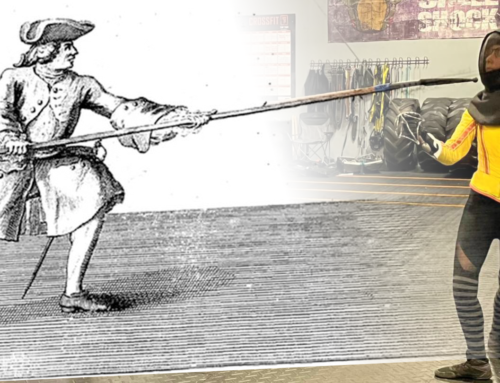
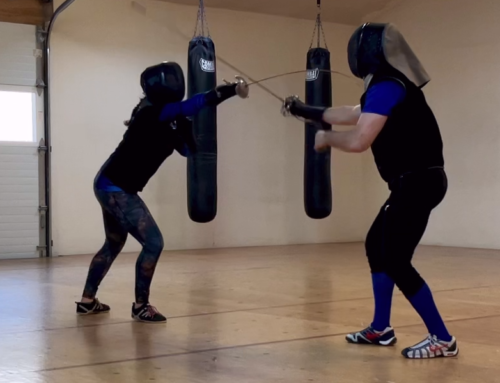
Leave A Comment